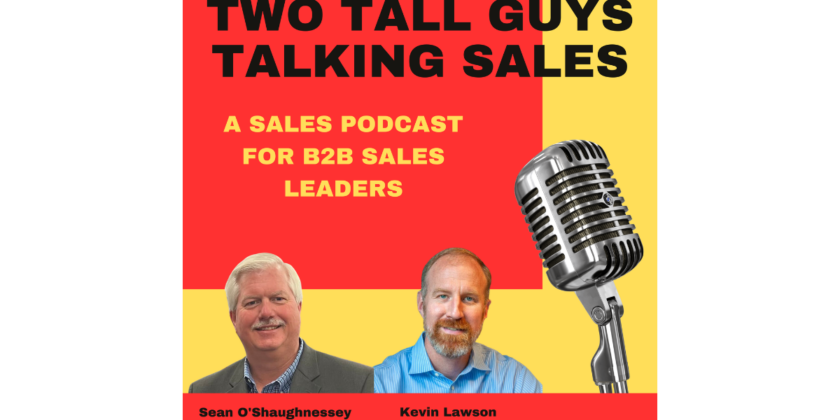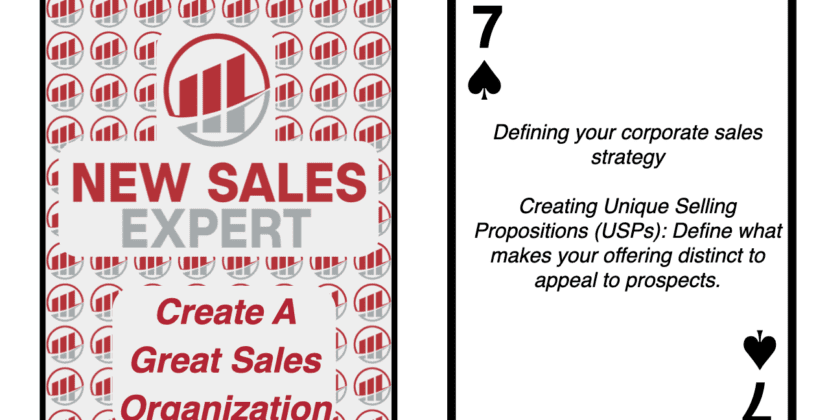
Business-to-business (B2B) sales is more than selling a product or service. It involves a strategic approach that includes understanding the customer’s needs, differentiating your offering, and building trust. This strategic approach is often called the three-legged stool of sales: Resonate, Differentiate, and Substantiate.
Resonating with customers is the first step (leg) in the sales process. It involves answering the questions “Why should the customer act?” and “Why should they act now?” To resonate with customers, you must understand their goals and how your product or service can meet them. This requires careful listening, understanding, and empathy.
The second leg of the stool is differentiation. This answers the question, “Why choose us?” Differentiation is all about highlighting what makes your product or service unique from the competition. This could be anything from superior quality and innovative features to excellent customer service. It’s crucial to communicate this differentiation clearly and effectively to the customer.
Read the rest of the article…
In B2B sales, professionals grapple with many challenges that can make or break their success. Clearly articulating a unique selling proposition (USP) stands out as a cornerstone for distinguishing oneself from the competition. This capability is not just a nicety—it’s a necessity. As businesses strive to carve out their niche in crowded markets, understanding and communicating what makes them distinct becomes paramount.
The concept of a USP or value proposition is often used interchangeably, yet its essence lies in differentiation. It’s about answering the pivotal question: why should customers choose you over others? This query isn’t trivial; it’s fundamental to the survival and growth of any business. As we delve deeper, it becomes evident that the challenge isn’t just about having a unique offering but about ensuring that every sales and leadership team member can communicate this uniqueness consistently and effectively.
The repercussions of failing to do so are significant. A disjointed message can lead to confusion in the marketplace, eroding trust and making it difficult to attract and retain customers. Furthermore, in an era where talent is a key competitive advantage, a clear and compelling USP can also be a magnet for attracting top sales talent. Articulating what sets a company apart is crucial for winning customers and building a strong, cohesive sales team.
Achieving alignment on a USP requires a deliberate effort. It involves going beyond superficial statements that could apply to any company and digging deep to identify what truly makes your business special. This process can be challenging, requiring businesses to engage in introspection and sometimes difficult conversations. However, the rewards of getting it right are substantial. A well-articulated USP can be the foundation for all sales and marketing efforts, providing a clear, compelling reason for customers to choose your company.
One effective strategy for uncovering your USP is to engage directly with your customers. Businesses can gain often overlooked insights by understanding why they chose your company and what they value most about your offering. This customer-centric approach helps refine your USP and ensures that it resonates with the people you aim to serve.
Furthermore, consistency in communication is key. It is crucial that everyone from the sales team to the marketing team and the CEO can articulate the USP consistently. This doesn’t mean reciting a scripted message but rather understanding the core essence of what makes the company unique and being able to convey that in various contexts.
Communicating a unique selling proposition is not just a sales challenge; it’s a strategic imperative for businesses aiming to thrive in the competitive landscape of B2B sales. It requires a concerted effort to identify, articulate, and consistently communicate what makes your business unique. By doing so, companies can differentiate themselves in the eyes of both customers and potential sales talent, paving the way for sustained growth and success.
Immediate actions that you can use
- Conduct a USP Workshop: Organize a workshop with your sales and leadership teams to dive deep into your current unique selling proposition (USP). Use this session to critically assess whether your USP truly differentiates your offering from the competition and aligns with your target customers’ needs. Employ techniques like customer feedback analysis and competitor comparison to refine your USP, ensuring it’s both compelling and clearly communicated by all team members.
- Revise Sales Materials and Messaging: Review and revise your sales collateral, website content, and social media messaging to ensure consistency and alignment with your refined USP. This action ensures that all touchpoints with potential customers reinforce the unique benefits of choosing your service or product. Consider involving a cross-functional team in this process to guarantee that the USP is clearly and effectively integrated across all platforms and materials.
- Engage in Customer Conversations: Starting today, initiate conversations with a selection of your most valued customers. The objective is to understand why they chose your company over others. Ask specific questions to uncover the aspects of your product or service they find most valuable and unique. Use these insights to validate your USP and discover potential areas for further differentiation. This direct feedback will be invaluable in fine-tuning your sales strategy and enhancing your competitive edge in the market.

Welcome to another insightful episode of “Two Tall Guys Talking Sales,” where hosts, Kevin Lawson and Sean O’Shaughnessey, delve into the often-overlooked realm of consumable sales. In this episode, they explore strategies for making that initial sale and ensuring repeat business in a competitive market. Whether you’re selling paper, steel, lubricants, or any consumable product, this episode is packed with valuable insights for sales professionals at all levels.
Key Topics Discussed
- The Importance of Being a Trusted Advisor: Understanding the significance of building solid customer advisory relationships in consumable sales.
- Selling Beyond the Product: How to add value and differentiate yourself when selling widely available products that are similar across competitors.
- Strategies for New Territory Development: Tips for sales leaders and salespeople on effectively breaking into and growing new sales territories.
- Crafting a Unique Selling Proposition (USP): The necessity of developing a compelling USP, even for distributors of similar products.
- Role of Sales Managers and CEOs: The importance of leadership in providing tools and processes to support the sales team in delivering value.
- Maintaining Customer Satisfaction: Strategies for keeping customers engaged and ensuring repeat business in a competitive environment.
Key Quotes
- Sean: “The value you bring is you. The value you bring is your ability to understand the prospect, your ability to guide the prospect.”
- Kevin: “Figure out for yourself what makes the most value for your customers. When they say, ‘thank you,’ what do they say thank you for?”
Additional Resources
- Book: “Challenger Sale” – Recommended for understanding the concept of challenging and driving customer business – https://a.co/d/cIUwphe.
- Book: “Eliminate Your Competition” by Sean O’Shaughnessey https://a.co/d/4qCVNEP.
Summary
In this episode, Kevin and Sean provide a deep dive into the world of consumable sales, emphasizing the importance of being more than just a salesperson – being a trusted advisor. They discuss the necessity of understanding your product and your customer, crafting a unique selling proposition, and the critical role of sales managers and CEOs in empowering their teams. Whether you’re a seasoned sales professional or just starting, this episode offers practical advice and strategies to excel in the competitive market of consumable sales. Tune in to “Two Tall Guys Talking Sales” for these and more invaluable sales insights.

Welcome to another insightful episode of Two Tall Guys Talking Sales, hosted by Kevin Lawson and Sean O’Shaughnessey. In this episode, the duo delves into the often overlooked but crucial sales aspect – selling consumable products. They explore strategies and insights for salespeople who deal with regularly consumed and repurchased products, such as manufacturing supplies, paper products, and even everyday items like toilet paper.
Key Topics Discussed
- The Unique Challenges of Selling Consumable Products: Understanding the dynamics of selling products that are regularly used up and repurchased.
- Strategic Sales Approaches: How to effectively sell consumable products in competitive markets.
- The Importance of Value Proposition: Emphasizing the significance of a unique selling proposition (USP) in consumable product sales.
- Salesperson’s Role in Consumable Sales: The critical impact of the salesperson’s understanding of the customer’s business and needs.
- Territory Management and Growth Strategies: Effective methods for expanding sales territories and managing customer accounts.
- Cross-Selling and Team Collaboration: Leveraging the strengths of a sales team through cross-pollination of skills and coaching.
Key Quotes
- Sean: “In the environment we’re talking about here, where it’s a consumable product… the quality of the salesperson comes to play in a big way.”
- Kevin: “You need to know where and how you compete. It’s as simple as that. Who do I call on? How do I compete? Is it price? Is it value?”
Additional Resources
- Sean O’Shaughnessey’s book “Eliminate Your Competition” for more in-depth sales strategies – https://amzn.to/2K37ugx
Summary
In this episode, Kevin and Sean provide valuable insights into the world of selling consumable products. They emphasize the importance of understanding the unique challenges of this market, including the need for a strong value proposition and the crucial role of the salesperson in understanding and meeting customer needs. The discussion also covers effective territory management and the benefits of leveraging team strengths for cross-selling. This episode is a must-listen for sales professionals looking to excel in the consumable products market and for those seeking to enhance their sales strategies in competitive environments.
Listen to this episode of Two Tall Guys Talking Sales to gain valuable insights and strategies for excelling in the consumable products market, and to learn how to effectively grow your sales territory and manage customer relationships

Sales Strategy Isn’t Just About Hitting Numbers: It’s Your Operational Backbone for Success
A well-defined sales strategy is indispensable for long-term business success.
Importance of Market Segmentation
Don’t fall into the trap of a one-size-fits-all approach. Market segmentation is your tool to tailor unique strategies for distinct customer profiles, ensuring maximized reach and impact.
Crafting a Unique Selling Proposition (USP)
A compelling USP is your golden ticket in a saturated market. Your competitive edge makes your offer not just another option but the go-to solution for your target audience.
Sales Process Flowchart: Consistency is Key
A detailed sales process flowchart is the backbone of your sales execution. It provides a replicable structure and methodology, helping your team stay aligned and focused while enabling timely interventions to address bottlenecks.
Balance Short-term Gains and Long-term Objectives
Quick wins can boost morale but cannot derail your broader goals. CEOs must ensure alignment between immediate gains and long-term strategic objectives, further amplified when integrated with marketing initiatives.
Culture of Continuous Learning
Stagnation is your enemy. Cultivate a culture where past data serves as a scoreboard and a treasure trove of insights for future strategy adjustments.
Regular Reviews for Adaptability
The market won’t wait for you to catch up. Periodic reviews and adjustments ensure your strategy is a living, breathing entity, agile enough to adapt to market conditions and competitive pressures.
Remember, a well-defined, adaptable sales strategy is the key to corporate excellence. Take control and be the strategic architect of your company’s success.

Crafting the Beacon in Sales: The Art of Unique Selling Propositions (USPs)
The challenge in the modern B2B marketplace isn’t merely about getting noticed but about leaving an indelible mark. For businesses navigating this complex market, the guiding light—their Unique Selling Proposition (USP)—is the deciding factor. But why is a USP so quintessential, and how does one etch it masterfully?
Picture, if you will, an animated marketplace: myriad sellers, each echoing their offerings. Amidst this cacophony, it’s not the loudest but the most distinct voice that captures attention. Here lies the sublime difference between mere visibility and impactful distinction, a difference the USP embodies. Drawing from historical insights, companies that have adeptly sculpted a lucid USP not only differentiated themselves but also witnessed significant enhancement in sales. Consider a brand that doesn’t just sell a product but an ethos—for every purchase, there’s a contribution to a larger cause. Such compelling USPs have been demonstrated to escalate sales metrics impressively.
However, the journey of crafting a USP isn’t always smooth sailing. Companies often grapple with the challenge:
- The Quest for Distinctiveness: Especially pertinent to sprawling enterprises, there exists an often-arduous search for that unique element. It’s like a ship amidst crosswinds, grappling for a definitive direction.
- The Illusion of Resonance: A USP might be alluring, but if it fails to resonate with its core audience, it’s a misstep—a beacon that misguides rather than leads.
Navigating these challenges to etch a resonating USP is where the analytical marries the artistic. First, there’s the introspective dive—a company must be deeply attuned to its ethos, its foundational promises. Only when a company is profoundly aware of its essence can it then articulate that message to its prospects. Subsequent to this is the empirical phase, where understanding the audience becomes pivotal. What are their aspirations? Their values? Drawing upon robust market research facilitates the alignment of a USP with these consumer insights. The final stretch of this journey is iterative refinement. Much like an artist refining his masterpiece, a compelling USP emerges from continuous honing, molded by feedback and real-world resonances.
Yet, one must remember—a USP transcends being a mere slogan. In this information-rich epoch, consumers have a heightened sense of discernment. They can swiftly sieve out authentic commitments from hollow echoes. Thus, at the core of a compelling USP is the pulse of authenticity. It isn’t just what you profess; it’s what you consistently manifest.
The Unique Selling Proposition stands as a sentinel in the marketplace’s panorama. It’s not just a strategy or a tagline—it’s an assertion of identity, a clarion call proclaiming, “This is our essence. This is why we’re unparalleled.” For the architects of business strategy, CEOs, and sales visionaries, this isn’t just a task—it’s a craft. A melding of introspection, market acumen, creativity, and authenticity. In the sales narrative’s vast tapestry, a well-woven USP isn’t just a strand—it’s the golden thread that binds the story together, making it both memorable and mesmerizing.

Dive deep into the world of competitive analysis with Kevin Lawson and Sean O’Shaughnessey in this engaging episode of Two Tall Guys Talking Sales. In the fast-paced world of sales, it’s not just about knowing your product, but about understanding your competition, your customers, and the nuances that drive decisions. Let Kevin and Sean guide you through actionable insights to elevate your sales game.
Key Topics Discussed:
- The Power of Competitive Analysis: Unlock the benefits of understanding your competition and how it empowers you as a sales leader.
- Understanding ‘No Decision’: Learn why some prospects choose to remain indecisive and how you can navigate this challenge effectively.
- The Role of SWOT in Sales: Deciphering how SWOT, PESTEL, and SOAR analyses can help shape your sales strategies.
- Unpacking Unique Selling Proposition (USP): Knowing your USP and leveraging it against your competitors is important.
- Importance of Feedback in Pricing: Sean emphasizes the need for real-time feedback, especially when your price points are met with resistance.
- The Salesperson as a Guide: The role of a salesperson is to guide clients, understand their needs, and sell existing products confidently.
Key Quotes:
- Kevin: “No decision comes, in my opinion, when you haven’t done a good job qualifying the prospect.”
- Sean: “Looking at companies that are massively successful… It’s just a good way for a company to get better. Looking at those people and learning from them is really, really important.”
- Kevin: “If you’ve already thought through how they measure value, you know how to talk to them. You become a better salesperson because you put in the work.”
- Sean: “Your job is to sell the product that exists today, not the product that you wish they would hurry up and build.”
Additional Resources:
- Microsoft’s package offerings
- Previous episode on Competitive Analysis
Summary:
In the competitive realm of sales, it’s not just about standing out, but about understanding every piece of the puzzle. Whether it’s diving deep into SWOT analyses, ensuring that your pricing strategy aligns with market expectations, or guiding your client toward a mutually beneficial decision, every step matters. Join Kevin and Sean as they unpack these topics and more, providing you with actionable strategies to ensure your sales pitch stands out. If you’re serious about mastering the art of sales, this is an episode you won’t want to miss. Dive in now!

